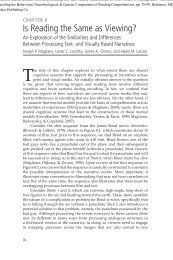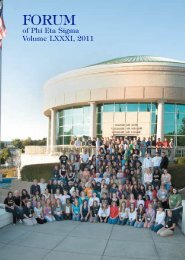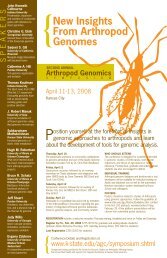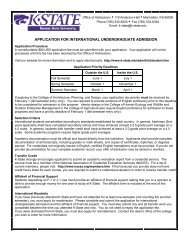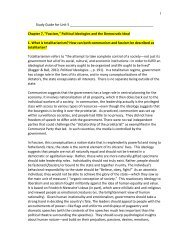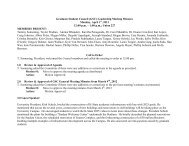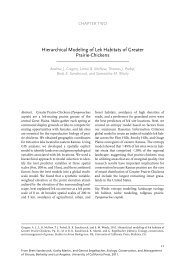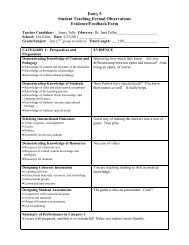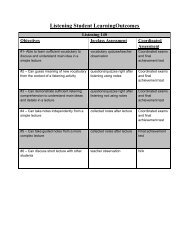Estimation of Demographic Parameters from Live ... - BioOne
Estimation of Demographic Parameters from Live ... - BioOne
Estimation of Demographic Parameters from Live ... - BioOne
Create successful ePaper yourself
Turn your PDF publications into a flip-book with our unique Google optimized e-Paper software.
Burnham model has been applied to blacklip abalone (Haliotis<br />
rubra; Catchpole et al. 2001), turtles (3 spp.; Bjorndal et al.<br />
2003, Fonnesbeck and Dodd 2003, Semin<strong>of</strong>f et al. 2003),<br />
Eurasian golden-plovers (Pluvialis apricaria; Piersma et al.<br />
2005), peregrine falcons (Falco peregrinus; Craig et al. 2004),<br />
owls (2 spp.; Francis and Saurola 2002, Altwegg et al. 2003),<br />
and western bluebirds (Sialia mexicana; Keyser et al. 2004),<br />
whereas the Barker model has been applied to little penguins<br />
(Eudyptula minor; Johannesen et al. 2003), peregrine falcons<br />
(Kauffman et al. 2003), Finsch’s oystercatchers (Haematopus<br />
finschi; Sagar et al. 2002), snowy plovers (L. E. Stenzel, Point<br />
Reyes Bird Observatory, unpublished data), grey seals (Hall et<br />
al. 2001), and humpback whales (Megaptera novaeangliae,<br />
Mizroch et al. 2004). Joint models for live-encounter and<br />
dead-recovery data have provided some <strong>of</strong> the first robust<br />
estimates <strong>of</strong> true survival (S) and site fidelity (F) that are not<br />
confounded by other probabilities. Moreover, joint models<br />
have permitted explicit tests <strong>of</strong> the effects <strong>of</strong> age, sex, and<br />
environmental conditions upon variation in site fidelity and<br />
other demographic parameters.<br />
The main hurdle for use <strong>of</strong> the Burnham and Barker<br />
models is that multiple sources <strong>of</strong> information for tagged<br />
animals are unlikely to be available for most wildlife<br />
populations. The 6 studies where investigators applied<br />
Barker models to nongame species are encouraging<br />
exceptions. The penguin and seal population studies were<br />
both conducted at sites where tourist operations provided<br />
opportunities to view wildlife. The remaining 4 studies were<br />
based on coordinated networks <strong>of</strong> experienced volunteers<br />
who contributed resighting data for species <strong>of</strong> conservation<br />
concern. The geographic distribution <strong>of</strong> the dead-recovery<br />
data is key to the successful application <strong>of</strong> joint models. In 2<br />
studies, investigators recovered dead individuals in the same<br />
restricted sampling area where animals originally had been<br />
marked (Fonnesbeck and Dodd 2003, Keyser et al. 2004).<br />
Although the recovery regions were small, the authors could<br />
still consider S to be an estimate <strong>of</strong> true survival because the<br />
study populations were geographically isolated. Nevertheless,<br />
if permanent emigration <strong>from</strong> the recovery region is<br />
possible, then estimates <strong>of</strong> survival <strong>from</strong> joint models are<br />
best viewed as a probability <strong>of</strong> apparent survival / and not<br />
true survival S (Francis and Saurola 2002).<br />
Management Implications<br />
Effective management <strong>of</strong> wildlife populations requires the<br />
best possible estimates <strong>of</strong> survival and other demographic<br />
rates. Mark–recapture analyses <strong>of</strong> live-encounter data are<br />
likely to remain an important source <strong>of</strong> information,<br />
especially for nongame species. The main drawback to use<br />
<strong>of</strong> mark–recapture models for live-encounter data is that it<br />
rarely is possible to estimate true survival rates, and<br />
investigators must consider ecological factors affecting both<br />
true survival (S) and site fidelity (F) when interpreting<br />
estimates <strong>of</strong> apparent survival (/) <strong>from</strong> JS and CJS models.<br />
Empirical applications <strong>of</strong> advanced mark–recapture models<br />
are a logistical trade-<strong>of</strong>f between the requirements <strong>of</strong><br />
collecting additional information, and the potential for<br />
obtaining a better understanding <strong>of</strong> wildlife demography.<br />
Time-since-marking models and temporal symmetry models<br />
require at least 4 years <strong>of</strong> data but are useful for<br />
controlling for transients and calculating rates <strong>of</strong> population<br />
change. Multi-strata models require inclusion <strong>of</strong> categorical<br />
states but allow calculation <strong>of</strong> transition rates for dynamic<br />
strata. Robust design models require additional sampling<br />
within sampling occasions but allow decomposition <strong>of</strong><br />
encounter rates into site propensity and true detection rates.<br />
Similarly, joint models require multiple sources <strong>of</strong> information<br />
but allow partitioning <strong>of</strong> apparent survival into true<br />
survival and site fidelity.<br />
Advances in analyses <strong>of</strong> live-encounter data are likely to<br />
proceed in 3 major directions: creative applications <strong>of</strong><br />
available models, ongoing development <strong>of</strong> new models, and<br />
increased use <strong>of</strong> Bayesian approaches to model fitting.<br />
Standard CJS and multi-strata models each have a large<br />
literature, but most <strong>of</strong> the advanced models have untapped<br />
potential for addressing demographic questions in wildlife<br />
ecology. Mark–recapture methods are an exciting area <strong>of</strong><br />
research and new models address uncertainty in state<br />
assignment (Nichols et al. 2004), combine robust design<br />
methods with other models (Lindberg et al. 2001, Hines et<br />
al. 2003, Kendall et al. 2003, Ramsey 2005), and combine the<br />
best features <strong>of</strong> multiple models (Barker and White 2004).<br />
Applications <strong>of</strong> new models may be limited by a lack <strong>of</strong><br />
goodness-<strong>of</strong>-fit tests for assessment <strong>of</strong> over-dispersion and<br />
by data requirements if model structure is complex. Finally,<br />
most models for live-encounter data rely on maximum<br />
likelihood estimators, which are based upon a fixed-effects<br />
framework. Biometricians have developed Bayesian approaches<br />
to model fitting for a subset <strong>of</strong> mark–recapture<br />
models, including the CJS (Brooks et al. 2000), and multistrata<br />
models (King and Brooks 2002). Bayesian methods<br />
have distinct advantages, including development <strong>of</strong> hierarchical<br />
models that treat demographic parameters as<br />
random variables (Cam et al. 2002, Royle and Link 2002,<br />
Link and Barker 2005). In the future, wildlife ecologists<br />
should design studies that take advantage <strong>of</strong> the best possible<br />
statistical procedures, now that a range <strong>of</strong> alternative models<br />
and model-fitting approaches are available for estimation <strong>of</strong><br />
survival and other demographic parameters.<br />
Acknowledgments<br />
I thank D. L. Murray and B. Patterson for the invitation to<br />
present this paper in a symposium on estimation <strong>of</strong> survival<br />
rates at the national meeting <strong>of</strong> The Wildlife Society in<br />
Calgary, Alberta. E. G. Cooch and W. L. Kendall <strong>of</strong>fered<br />
constructive comments in reviews <strong>of</strong> a previous draft <strong>of</strong> the<br />
manuscript. The Division <strong>of</strong> Biology at Kansas State<br />
University provided financial support during preparation <strong>of</strong><br />
this article. I acknowledge a great intellectual debt to the<br />
biometricians who developed the statistical models that I<br />
have discussed in this article. I am grateful to have access to<br />
these tools, and I will be glad if this summary review<br />
encourages other wildlife ecologists to take advantage <strong>of</strong><br />
mark–recapture methods.<br />
1514 The Journal <strong>of</strong> Wildlife Management 70(6)



